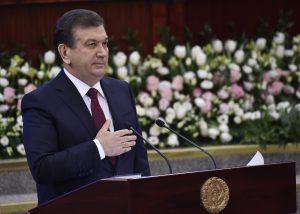On September 9, the Liberal Democratic Party of Uzbekistan nominated the incumbent president, Shavkat Mirziyoyev, to be the party’s candidate in Uzbekistan’s October 24 presidential election.
Mirziyoyev will win the election. Ever since the country became independent in late 1991, the outcome of a presidential election has never been in doubt.
This is one of the problems Mirziyoyev has with attempting to project the image of a new Uzbekistan, and himself as a reformer. He has made some significant changes since coming to power in 2016, but some aspects of Uzbek politics look similar or the same as they did when the authoritarian leader Islam Karimov was Uzbekistan’s president.
Stepping Out of the Shadows
Mirziyoyev was appointed Uzbekistan’s prime minister in 2003. In 2016, after Karimov’s death was announced on September 2, Senate Speaker Nigmatulla Yuldashev became acting president, in accordance with the constitution. But on September 8, when parliament convened to confirm Yuldashev’s temporary position, Yuldashev deferred to Mirziyoyev since the latter was “better known” to Uzbekistan’s people.
Better known than Yuldashev to be sure, but when Karimov was alive, no government officials except Karimov received much media attention in Uzbekistan. Mirziyoyev’s reputation was that of an enforcer for Karimov, who threatened and even physically assaulted those who failed to carry out their tasks and meet government quotas.
The process by which Mirziyoyev became leader was opaque. Karimov likely died on August 27, but that information was withheld until after Uzbekistan marked its independence day on September 1. Then-Finance Minister Rustam Azimov and then-National Security Service (SNB) chief Rustam Inoyatov were also strong contenders to take Karimov’s place. Apparently, they all agreed on Mirziyoyev assuming power. The reclusive Inoyatov was characteristically quiet about the transfer of power, but Azimov appeared on state television on September 9 to say he supported Mirziyoyev being named interim president.
A snap election was called for December 4, 2016. During the campaign the same glowing adjectives state media used to describe Karimov appeared before Mirziyoyev’s name. Mirziyoyev won, receiving more than 90 percent of the votes. It looked like business as usual in Uzbekistan.
A New Era
However, at the time Mirziyoyev took power, Uzbekistan had some pressing concerns. Something needed to be done about the economic malaise the country had fallen into during the last years of Karimov’s rule. Uzbekistan’s government had a reputation as a rights-abuser and a fickle ally, and had become an isolationist state. The scowl that was so often seen on Karimov’s face epitomized his style of leadership. He was harsh, threatening, and unsympathetic to the point of not lifting a finger to keep his own nephew, an independent journalist, out of a psychiatric hospital.
Whatever people thought about Mirziyoyev as prime minister, the person who became president was publicly very different than earlier tales had portrayed him.

































